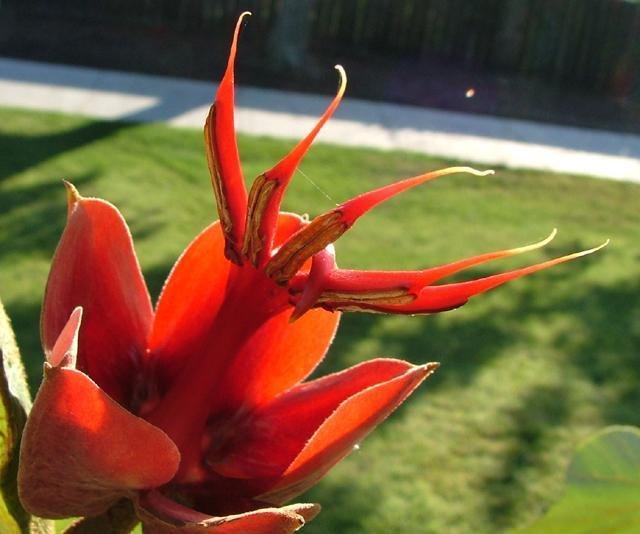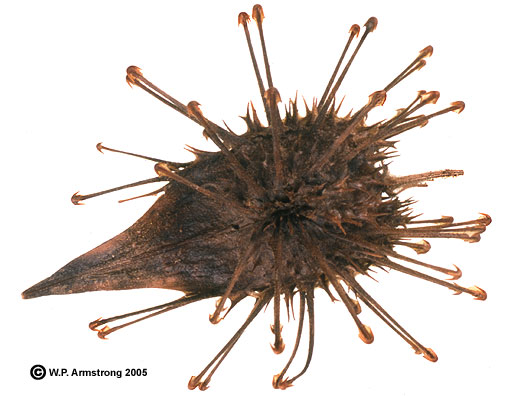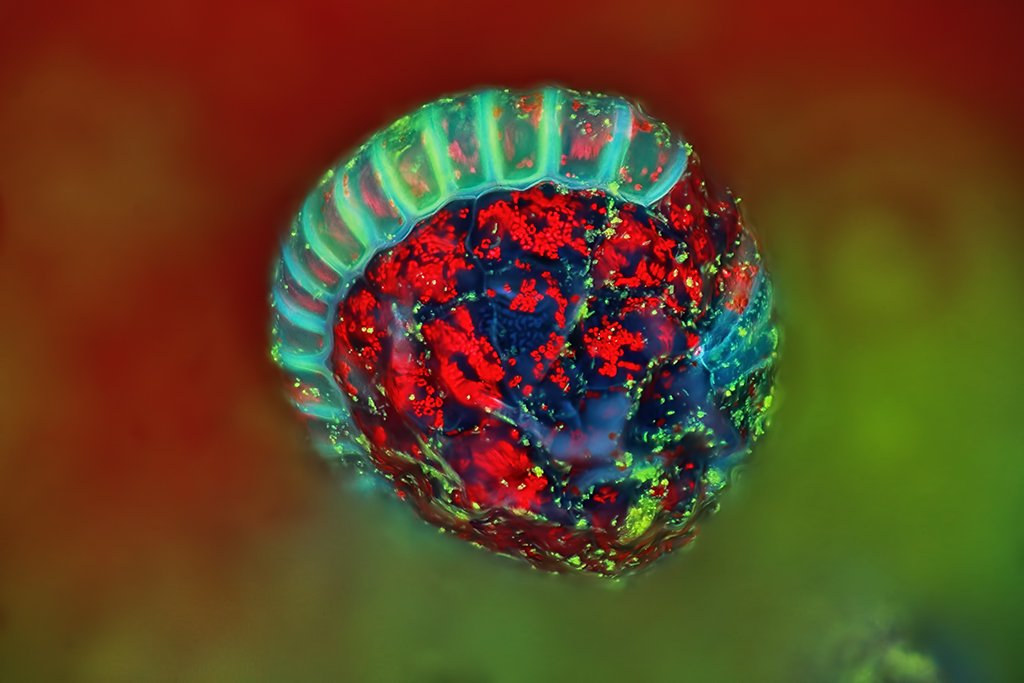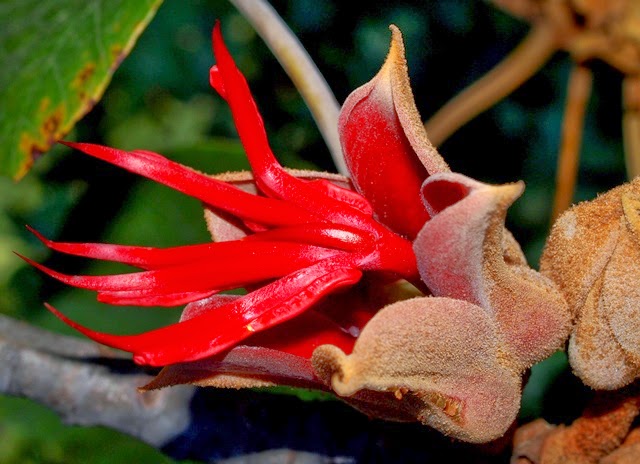
Seeds from the Heart's Blood Flower begin to germinate as soon as they come into contact with blood. Without ready muscle tissue in which to dig roots, they will starve and die. It won't germinate at normal body temperatures, however, so it is mostly found on corpses and large battlefields.
The Heart's Blood Flower seed is an absolutely miniscule husk (about 2mm long) covered in dozens of very sharp, hollow, harpoons. It will hitch a ride on any material, fur or flesh and is nearly impossible to remove. When a harpoon comes into contact with blood it will activate and become sensitive to any disturbance, shooting out like the nematocyst of a jellyfish and penetrating the flesh structure of whatever brushes it. Unlike a jellyfish, however, there are no stinging cells in its harpoons; there are only roots. As long as the flesh of the host body is at normal body temperatures, the seed will stay dormant. Once the body starts to cool, the roots grow, sending networks through the blood and into the vasculature of the body. If a root comes in contact with cylindrical muscle fibers (such as found in skeletal and cardiac muscles) it will start digesting them, causing the seed to sprout rapidly, growing to showy crimson blossoms in less than two hours. This is why it is called the heart's blood flower, since the roots travelling through the blood vessels inevitably end up in and suffuse the heart tissue.
Like most parasitic plants, the Heart's Blood Flower has no foliage. It does not need to photosynthesize and instead get's all its energy and nutrients from the host body. Without the need, therefore, of any foliage, it puts all its effort into creating a carpet of blood-red flowers that spill from the open wounds of corpses.
The crimson flowers (see cover picture) smell surprisingly and pleasantly sweet. The flies attracted by the wounds of the host body are also attracted to the flowers and vice versa; and they pollinate the flowers.
When a flower becomes pollinated, it will start siphoning the gases generated by its decomposing host into its ovaries, creating a balloon-like seedpod about the size of a golf ball with a rigid vertical spring-like spine. (see inset picture at left) When the balloon is fully inflated the globs of coagulated blood and seeds are visible through its thinly stretched skin. And when it is disturbed, the membrane rips and spine-spring inverts to tear the balloon asunder and thrust the tiny seeds into the air and surrounding surfaces. If nothing disturbs it, the balloon will eventually split due to its own internal gas pressure. This is usually accompanied by a soft >piff< sound. The spread of the seeds can be extensive, some carried well over fifty meters away. And with their hitchhiking tendency on fur, feathers and fabrics, the promulgation of the seeds is far and wide.
Heart's Blood Flowers have an extremely rapid growth rate. One can reach full inflorescence in just a few hours after a body cools. The flowers can last up to a week if they are not pollinated. Once pollinated, seedpods mature in about a day.
Survivors on battlefields will talk of how the blood red flowers grow from the wounds of the fallen, spilling from the bodies as if they were the blood instead. The sweet smell of the flowers can have a strong association to these traumatic experiences for some veterans, while others take comfort in the beauty that comes from such ugliness.
After battles, wounded soldiers will often find aborted heart's blood rootlings in their clothing where they had bled. The plants began to grow in the cooling blood on their clothing but could not grow any further due to the soldier remaining alive.
Can be found almost anywhere.
People who cultivate this flower usually place an animal's heart filled with blood and seeds in a sealed glass container or a dedicated room to keep the smell of decomposition contained. This makes them expensive and thus rare and coveted. It helps that the flower is strikingly attractive in shape and color and has such a unique and sweet scent. Heart's Blood Flowers are a favorite for arrangements and gifts and a cut Heart's Blood Flower has become one of the most ardent symbolic expressions of love in North America.
The cover image shows the Heart's Blood flower ready to spread it's pollen.
The following image is from a cultured specimen grown from a disembodied heart
To the Osawkee tribe, the blooming of a Heart's Blood is a mark of the spirit's passing to the spirit world. Tribesmen will collect Heart's Blood seeds in their travels and every member will always have a few in their possession kept in a fold or locket worn around the neck or wrist.
When an Osawkee tibesman dies, it is customary for their heart to be cut out, filled with the seeds they were carrying, and placed in the tossed earth above the grave. This would only be necessary of the flowers didn't germinate on their own, and would also require someone to provide the blood necessary to kickstart it. This is not a problem as volunteers consider this an honor to show the deceased their respect or one last act of devotion. The celebrants then say prayers until the flower blooms, which could take more than an hour. It is customary for the next of kin to return and collect seeds from these flowers, thereby creating a connection with the spirit of the deceased and allowing their spirits to meet again when their own time comes.
Cover image:
A small tree in local park, Fremont, CA.
by
Dave's Garden
Comments
Please Login in order to comment!









Nice article. I like the ritual that you added in the sidebar and the meaning of the flower to this tribe. The plant itself also has a nice concept. A point to improve though is perhaps to avoid using 'and' in the beginning of a sentence, especially if not necessary.
Thanks for the comment. I totally try to avoid starting sentences with and. Thanks for pointing that out as well.